Bharat
Kingdoms of Ancient India according to Hindu Epics
Published
4 years agoon
By
Vedic Tribe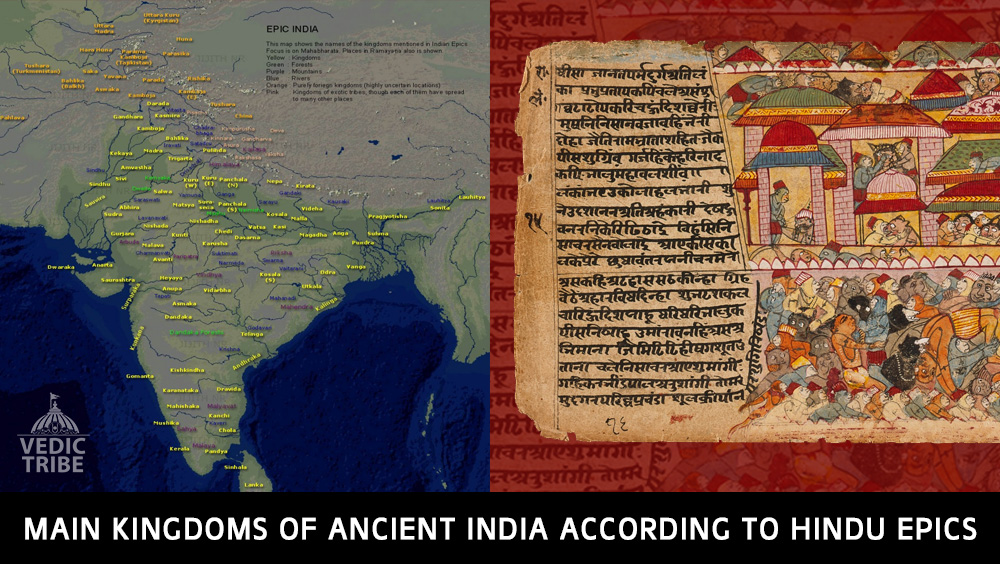
~ Excerpted from the book – Main Kingdoms of the Puru Clan
Panchala Kingdom extended from the Himalayas in the north to the River Charmanwati in the south during the period of Mahabharata. The Kuru, Surasena and Matsya kingdoms were to the west, and the forest of Naimisha was to the east. Later, Panchala was divided into Southern Panchala (Panchala proper ruled by King Drupada, the father-in-law of the Pandavas) and Northern Panchala (ruled by Ashwathama, the son of Drona. Drona was Drupada’s former friend who became his enemy later). The Ganges River separated the two Panchalas.
Panchala Kingdom extended from the Himalayas in the north to the River Charmanwati in the south during the period of Mahabharata. The Kuru, Surasena and Matsya kingdoms were to the west, and the forest of Naimisha was to the east. Later, Panchala was divided into Southern Panchala (Panchala proper ruled by King Drupada, the father-in-law of the Pandavas) and Northern Panchala (ruled by Ashwathama, the son of Drona. Drona was Drupada’s former friend who became his enemy later). The Ganges River separated the two Panchalas.
Northern Panchala had Ahichatra as its capital. It is identified as an archeological site near Ramnagar town of Uttar pradesh state. This kingdom extended from Himalayas to the river Ganga. Southern Panchala, or Panchala-proper, had Kampilya city as its capital, now a small town named Kampil near Farrukhabad in Uttar Pradesh. This kingdom extended from the Ganges River to River Charmanwati.
Lineage of Puru Kings up to the branching of the Panchala Tribe
Puru had by his wife Paushti three sons: Pravira, Iswara, and Raudraswa. Amongst them, Pravira was the perpetuator of the dynasty. Pravira had by his wife Suraseni a son named Manasyu. Manasyu had for his wife Sauviri. Together they had three sons named Sakta, Sahana, and Vagmi. Raudraswa and the Apsara Misrakesi produced ten sons, and they all had sons. They are Richeyu, Kaksreyu Vrikeyu, Sthandileyu, Vaneyu, Jaleyu, Tejeyu, Satyeyu, Dharmeyu and Sannateyu the tenth.
Amongst them all, Richeyu became the sole monarch and was known by the name of Anadhrishti. Anadhristi had a son by the name of Matinara, who became a famous and virtuous king and performed the Rajasuya and the Ashwamedha. Matinara had four sons viz., Tansu, Mahan, Atiratha, and Druhyu. Amongst them, Tansu of great prowess became the perpetrator of Puru’s line.

Tansu produced a son named Ilina. Ilina and his wife Rathantara had five sons, Dushmanta, Sura, Bhima, Pravasu, and Vasu. The eldest of them, Dushmanta, became king. Dushmanta had by his wife Sakuntala an intelligent son named Bharata, who became king. Bharata gave his name to the race of which he was the founder. It is from him that the fame of that dynasty has spread so wide. Bharata and his three wives produced nine sons in all, but none of them were like their father, so Bharata was not at all pleased with them. Their mothers, therefore, became angry and killed them all. The procreation of children by Bharata, therefore, was attempted in vain.
The monarch then performed a great sacrifice and through the grace of Bharadwaja, obtained a son named Bhumanyu. Then Bharata, the great descendant of Puru, regarding himself as really possessing a son, installed that son as his heir-apparent. Bhumanyu begat upon his wife, Pushkarini, six sons named Suhotra, Suhotri, Suhavih, Sujeya, Diviratha and Kichika. During the virtuous reign of Suhotra, the surface of the whole earth was dotted all over with hundreds and thousands of sacrificial stakes. Suhotra and his wife Aikshaki produced three sons: Ajamidha, Sumidha, and Purumidha. The eldest of them, Ajamidha, was the perpetuator of the royal line. And he begot six sons. Riksha was born of the womb of his wife Dhumini; Dushmanta and Parameshthin, of his wife Nili; Jahnu, Jala and Rupina were born of his wife Kesini. Kushikas are the sons of Jahnu.
All the tribes of the Panchalas are descended from Dushmanta and Parameshthin, two sons of the second wife of Puru, King Ajamidha.
War between Panchalas and the Forefathers of Kurus
A continuous war between the Kurus and Panchalas led the defeated Kurus to be exiled from their kingdom. They lived in the forests on the banks of the Sindhu. Later, the Kurus retook their capital.
Riksha, who was older than both Jala and Rupina, became king. Riksha begat Samvarana, the perpetrator of the royal line. While Samvarana, the son of Riksha, was ruling, there occurred a great loss of people from famine, pestilence, drought, and disease. The Bharata princes were beaten by the troops of enemies.
The Panchalas, setting out to invade the whole land with their four kinds of troops, soon brought the whole land under their sway. And with their ten Akshauhinis, the King of the Panchalas defeated the Bharata prince. Samvarana then with his wife and ministers, sons and relatives, fled in fear and took shelter in the forest, on the banks of the Sindhu River, extending to the foot of the western mountains. There the Bharatas lived for some thousand years, within their fort. One day, a long time after they began living there, the sage Vasishtha approached the exiled Bharatas.
It is said that Vasishtha (becoming the priest) installed the Bharata prince in the sovereignty of all the Kshatriyas. The king retook the capital that had been taken away from him and once more made all monarchs pay tribute to him. The powerful Samvarana, was thus installed once more in the actual sovereignty of the whole land.
Samvarana and his wife, Tapati (whose abode was on the banks of the River Tapati (Tapti, Maharashtra), the daughter of Surya (a king of the Solar Dynasty), produced a son named Kuru. This Kuru was exceedingly virtuous, and therefore he was installed on the throne by his people. It is after his name that the field called Kurujangala, in eastern Hariyana, has become so famous in the world. Devoted to asceticism, he made the field of Kurukshetra sacred by practising asceticism there. He was thus the founder of the Kuru dynasty and the Kuru Kingdom.
It seems that the Samvarana who retook the capital was another king in the line of the exiled king Samvarana. The sages in the line of Vasistha were priests of the Solar Dynasty of kings (especially the Ikshwakus) for many generations. This could be the reason why Samvarana, who took Vasistha as his priest, married from the Solar Dynasty. The history of Samvarana falling in love with Tapati, while he roamed in the vicinity of Tapati River (Maharashtra), and Vasistha’s help in getting the consent of King Surya, her father, to give her in marriage to Samvaran — all these are mentioned in the Mahabharata.
This map shows the locations of Kingdoms mentioned in the epic Mahabharata and Ramayana. The locations of the kingdoms are based on the current knowledge about their locations. Names of kingdoms are in yellow. Kingdoms outside ancient India, but which are mentioned in the epics, are in orange. Their locations are highly speculative. Pink coloured names are the territories of various tribes that have spread to many other places. “Rakshasa Kingdom” indicates the territory of Ghatotkacha. “Asura Kingdom” is the kingdom of Vrishaparvan, a royal sage asura. The river names are shown in blue, the mountains in purple, and forests in green as a background for the locations of the kingdoms. Most of these natural boundaries serve as the boundaries of the kingdoms.
The Partition of the Panchala Kingdom
Drona defeated Drupada, by means of his disciple Arjuna, to settle his old scores. Drona spoke as follows to the captive Drupada: ‘Thou toldest me before that none who was not a king could be a king’s friend. Therefore is it, O Yajnasena (Drupada), that I retain half thy kingdom. Thou art the king of all the territory lying on the southern side of the Bhagirathi (Ganga), while I become king of all the territory on the north of that river. And, O Panchala, if it pleaseth thee, know me hence for thy friend.’
On hearing these words, Drupada answered, ‘Thou art of noble soul and great prowess. Therefore, O Brahmana, I am not surprised at what thou doest. I am very much gratified with thee, and I desire thy eternal friendship.’
After this, Drona released the king of Panchala, and cheerfully performing the usual offices of regard, bestowed upon him half the kingdom. Thenceforth Drupada began to reside sorrowfully in the city of Kampilya within the province of Makandi on the banks of the Ganga filled with many towns and cities. And after his defeat by Drona, Drupada ruled the Southern Panchalas up to the bank of the Charmanwati River. Meanwhile Drona continued to reside in Ahichatra. Thus was the territory of Ahicchatra full of towns and cities, obtained by Arjuna, and bestowed upon Drona. (Later, Drona gave the rulership of Northern Panchala kingdom to his son Ashwathama and stayed at Hastinapura the capital of Kuru Kingdom.)
(Mahabharata, Book 1: Adi Parva, Chapter 140: Arjuna takes Drupada captive)
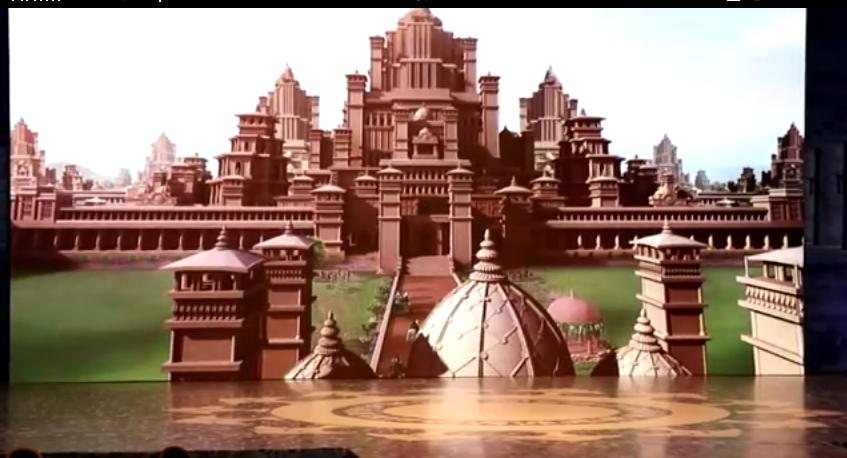
The Higher Status of the Panchalas and Kurus in Ancient India
The Kuru-Panchala was considered as the foremost among the provinces in Bharata Varsha (ancient India) comprised of the Kuru and Panchala Kingdoms. The Kurus and Panchalas were considered as foremost among the ruling tribes in ancient India, adhering closely to the Vedic religion. They were the proponents of the Vedic religion in its dogmatic and purest form. Other tribes imitated the practices of these tribes and thus got accepted into the Vedic religions.
Commencing with the Panchalas, the Kauravas, the Naimishas (a forest-country to the east of Panchala), the Matsyas, all these, know what religion is. The old men among the Northerners, the Angas, the Magadhas, without themselves knowing what virtue is, follow the practices of the Kuru-Panchalas.
The Kurus and the Panchalas comprehend from a half-uttered speech; the Salwas cannot comprehend till the whole speech is uttered. The Magadhas are comprehenders of signs; the Koshalas comprehend from what they see. The Mountaineers, like the Sivis, are very stupid. The Yavanas are omniscient; the Suras are particularly so. The mlecchas are wedded to the creations of their own fancy that other peoples cannot understand.
The Panchalas observe the duties enjoined in the Vedas; the Kauravas observe truth; the Matsyas and the Surasenas perform sacrifices. Beginning with the Matsyas, the residents of the Kuru and the Panchala countries, the Naimishas as well and the other respectable peoples, the pious among all races are conversant with the eternal truths of religion. The Kauravas with the Panchalas, the Salwas, the Matsyas, the Naimishas, the Koshalas, the Kasapaundras, the Kalingas, the Magadhas, and the Chedis who are all highly blessed, know what the eternal religion is.
Territories and Locations within the Panchala Kingdom
Kichaka Kingdom was a territory lying to the south of Panchala. It was ruled by the Kichaka clan of kings. They belonged to the Suta caste (offsprings of Kshatriyas upon Brahmana ladies). One among the Kichakas was the commander-in-chief of the Matsya army under King Virata. He was slain by Pandava Bhima due to his bad conduct towards the wife of Pandavas, viz Draupadi.
Kichaka kingdom also laid to the east of the Matsya Kingdom under the rule of King Virata. It seems that this territory was allied to both the Matsyas and Panchalas, with its own independent rulers. Its capital was mentioned to be Vetrakiya, on the banks of river Vetravati (Betwa) also known as Suktimati.
It is believed that the Pandavas lived in a small town named Ekachakra, belonging to this territory, during their wanderings after Duryodhana attempted to murder them at Varanavata (a Kuru city).
In the course of their wanderings the Pandavas saw the countries of the Matsyas, the Trigartas, the Panchalas and then of the Kichakas, and also many beautiful woods and lakes therein. They all had matted locks on their heads and were attired in barks of trees and the skins of animals. They attired in the garbs of ascetics. They used to study the Rig and the other Vedas and also all the Vedangas, as well as the sciences of morals and politics. Finally they met Vyasa. He told them: ‘Not far off before you is a delightful town.’ Saying this, he led them into the town of Ekachakra. On arriving at Ekachakra, the Pandavas lived for a short time in the abode of a Brahmana, leading an eleemosynary life.
During this period, Bhima slew a Rakhsasa named Baka (Vaka), at Vetrakiya. He controlled the affairs of the Kichaka Kingdom, making the king of the kingdom a name-sake king. By slaying the Rakshasa, Bhima freed that kingdom from Baka’s the reign of terror.
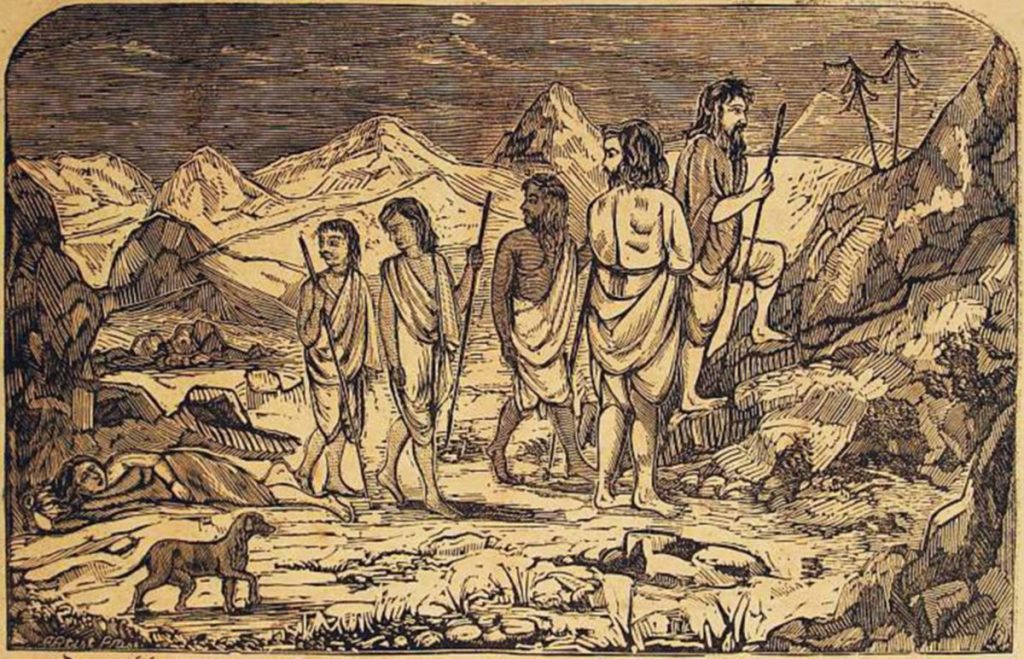
The Pandavas Journey from Ekachakra to Kampilya
The Pandavas proceeded towards Panchala with their mother, to attend an event of princess Draupadi’s. In order to reach their destination, they proceeded in a due northerly direction, walking day and night till they reached a sacred shrine of Siva, with the crescent mark on his brow. Then those tigers among men, the sons of Pandu, arrived at the banks of the Ganga. It was a forest called Angaraparna.
Here, they encountered a Gandharva named Angaraparna. After that encounter they went to a place called Utkochaka, where they met the sage Dhaumya. They appointed Dhaumya, the younger brother of Devala, as their pries. Then they proceeded towards the country of the southern Panchalas, ruled over by the King Drupada. They proceeded by slow stages, staying for some time within those beautiful woods and by fine lakes that they beheld along their way and entered the capital of the Panchalas.
Beholding the capital (Kampilya), as also the fort, they took up their quarters in the house of a potter. Desirous of beholding the Swayamvara (the self-choice ceremony of the princess), the citizens, roaring like the sea, all took their seats on the platforms that were erected around the amphitheatre.
The kings from diverse countries entered the grand amphitheatre by the north-eastern gate. The amphitheatre, which itself had been erected on an auspicious and level plain to the north-east of Drupada’s capital, was surrounded by beautiful mansions. It was enclosed on all sides with high walls and a moat with arched doorways here and there. The Pandavas, too, entering that amphitheatre, sat with the brahmanas and beheld the unequalled affluence of the king of the Panchalas. Arjuna won the competition set for winning Draupadi in the self-choice ceremony.

Kanyakubja Kingdom
The Kanyakubja kingdom is known as the modern day Kannauj district of Uttar Pradesh. During the reign of King Drupada of southern Panchala, this territory formed a part of the southern Panchala.
Gadhi, who was born in the race of King Kusika, and Gadhi’s son Viswamitra, were mentioned as the earlier rulers of this kingdom. Gadhi’s daughter was married to Richik, belonging to the Bhargava clan. Richika’s son was Jamadagni and Jamadagni’s son was the celebrated Bhargava Rama.
Gadhi mentions to Richika about a custom followed by their race; during marriage, the bridegroom should give to the bride’s side a dowry of 3,000 fleet steeds with brown color. (This custom is similar to that of Madra culture.) Richika get the horses from Varuna. (Note that Arjuna also got his excellent chariot, horses and bow from Varuna.) The horses reached Kanyakubja capital, crossing the river Ganga. The spot where they crossed the river was known by the name “Horse’s Landing Place.” Not far from Kanyakubja is a spot on the sacred bank of the Ganga, still famous among men as Aswatirtha, in consequence of the appearance of horses at that place.
Both the Kusikas and the Bhargava-Richikas seems to have links with the ancient western cultures (e.g., Bahlika culture, Madra culture, Rishika Kingdom, and Rishikas). Viswamitra (Kusika’s race) was born as a Kshatriya and later became a Brahmana, much like what was common in Madra cultures. Bhargava Rama (Richika’s race) was mentioned as an expert in the use of the battle-axe, which he got from the Kailasa region (Kailasa range, Tibet).
The location of the Rishika tribe, who were experts in the use of battle-axes, was not far away from this region. The custom of donating or accepting horses as dowry also indicate a north-western culture. It seems that neither the Bhargavas (and Richikas or Rishikas) nor the Kusikas maintained any distinctions such as Brahmana and Kshatriya upon themselves. However during the later periods, when the Vedic religion became rigid in its four-order caste-system, the Bhargavas were accepted as brahmanas and the Kusikas as Kshatriyas.
Gadhi was mentioned as a sovereign whose military force was exceedingly great. Viswamitra also was mentioned as possessing a large army and many animals and vehicles. Using those animals and vehicles, he used to roam around in forests in search of deer. During his wanderings he met the sage Vasistha and engaged in a dispute with this sage on the matter of the wealth of cattle possessed by the sage. Cattle wealth often caused disputes in the ancient kingdoms. Viswamitra had to encounter many local armies in his attempts to seize the cattle wealth, and he was vanquished by the local armies. After the defeat from Vasistha, Viswamitra adopted the life of an ascetic.
Bhargava Rama is also mentioned as defeating many tribes like Heheyas, and later adopting the life of an ascetic. Thus both the Kusikas and Bhargava-Richikas were warrior tribes who also were a priest-like class of people.
The Pandavas’s Route from Dwiata Lake to Matsya Kingdom
Panchala was one among the countries considered by the Pandavas in which to spend their 13th year of anonymity, along with the kingdoms of Chedi, Matsya, Surasena, Pattachchara, Dasarna, Navarashtra, Malla, Salva, Yugandhara, Saurashtra, Avanti, and the spacious Kuntirashtra. However, the Pandavas selected the Matsya Kingdom for their 13th year of anonymous life.
They ordered their chief servant, Indrasena, and the others to take with them the empty chariots and to speedily proceeded to Dwaravati. All the maid-servants of Draupadi were orderd to go to the Panchala kingdom. After that, the Pandavas left Dwaita lake in the Dwaita forest and proceeded to Matsya kingdom. Dhaumya, their priest, taking their sacred fires, set out for the Panchala Kingdom.
The Pandavas, traveling eastwards, reached the River Yamuna. Traveling along the southern banks of the Yamuna, they passed through Yakrilloma, Surasena. Then they turned westwards (possibly to deceive the spies of Duryodhana, who might have been following them), leaving behind on their right (the north side) the country of the Panchalas, and on their left (south side) that of the Dasarnas, entering the Matsya Kingdom.

Impact of Magadha Kings on Panchala
Due to the power of Magadha King Jarasandha, many ancient tribes had to shift their domains. Prominent among them were the Yadavas, who fled from Surasena Kingdom southwest, to Anarta Kingdom. The King of the Salwayana tribe with their brethren and followers, and the southern Panchalas and the eastern Kosalas also had to flee to the country of the Kuntis, which was south to these kingdoms.
Even though only King Jarasandha is mentioned, this situation might have arisen due to many generations of powerful Magadha kings, who were forefathers of Jarasandha. During the reign of Drupada, no shift in the location of southern Panchala is mentioned explicitly. If the situation was created by Jarasandha alone, and no other Magadha kings later or earlier to him, then this shift of southern-Panchala could be temporary.
Panchala’s Alliance with the Pandava King Yudhisthira
Bhima, during his military campaign to the east to collect tribute for Yudhisthira’s Rajasuya sacrifice, first visited the Panchala Kingdom after leaving his home city of Indraprastha. Only two tribes did not pay tribute unto Yudhisthira, viz., the Panchalas in consequence of their relationship by marriage, and the Andhakas and Vrishnis (Anarta Yadavas) in consequence of their friendship.
When the Pandavas were banished by Duryodhana to the woods, by unrighteously taking over their kingdom, both the Panchalas and Yadavas visited them along with other cousins like Chedis and Kekeyas. The Pandavas five sons by Draupadi spent some of their life in Panchala, and some in Dwaraka during the 13 year long exile of the Pandavas.
During their pilgrimage all around India, Yudhisthira asked the weak men among his followers to go to King Dhritarashtra of Kuru Kingdom, and if he didn’t take care of them, then to King Drupada of southern Panchala.
Yudhishthira and his followers, with the Matsya King Virata, began to make preparations for the Kurukshetra War. Virata and his relatives sent word to all the monarchs, and Panchala King Drupada also did the same. And at the request of the Pandavas, as also of the two kings of the Matsyas and the Panchalas, many kings gathered for their cause. Drupada sent his priest to Hastinapura for the initial peace talks.
Drupada, the king of the Panchalas, surrounded by his ten heroic sons, Satyajit and others, headed by Dhrishtadyumna. Well-protected by Shikhandi and having furnished his soldiers with necessary things, they joined the Pandavas with a full akshauhini.
Panchalas in Kurukshetra War
The Panchalas were the closest among all the allies of the Pandavas in the Kurukshetra War. Panchala prince Dhristadyumna was the commander-in-chief for the whole of the Pandava army. Many heroes from Panchala battled in the war. Most of them were alive till the end of the war, however all of them were slain by Ashwathama in an ambush, while they slept in their tents on the last day of the war.
Ashwathama was the ruler of half of the Panchala Kingdom, viz the northern Panchala, under Kuru King Duryodhana. Northern Panchala was then reduced to the status of a province of the Kuru Kingdom. This could be the political factor that caused the southern Panchalas to become kinsmen of the Pandavas, who were a rebel force in the Kuru Kingdom. By supporting the Pandavas in the Kurukshetra War, they might have sought to regain their lost Panchala territories.
Panchala Heroes
Satyajit is mentioned in Mahabharata as the commander-in-chief of the Panchala army under king Drupada, who fought against Arjuna, who was then a disciple of Drona, the preceptor in warfare in the Kuru Kingdom. He came to the Kurukshetra War leading the one akshouhini of the Panchala army. The brave warriors among the Panchalas, viz., Jayanta, Amitaujas and the great car-warrior Satyajit were mentioned as great car-warriors (Maharathas) by Bhishma.
The Panchala princes, Yudhamanyu and Uttamaujas were protectors of Arjuna’s car-wheels during the battle. Similarly, the Panchala prince Kumara is mentioned as one of the protectors of Yudhisthira’s car-wheels, along with another hero, Yugadhara (hailing from the city of Yugandhara, located somewhere to the west of Kurujangala, either in Hariyana or Punjab. Kumara and Yugandhara were slain by Drona, and Vyaghradatta, another Panchala prince, was slain by Drona along with Sinhasena.
Dhrishtadyumna, Sikhandin, Janamejaya (the son of Durmuksha), Chandrasen, Madrasen, Kritavarman, Dhruva, Dhara, Vasuchandra and Sutejana were mentioned as Panchala heroes, some of them being the sons of Drupada. The 10 sons of Drupada and his five sons are mentioned as participating in the Kurukshetra War. Suratha and Satrunjaya are mentioned as sons of Drupada slain by Ashwathama. Drupada’s three grandsons were also mentioned as battling in the war. Shikhandi’s son Khsatradeva was mentioned as battling in the war. Dhristadyumna’s sons, tender in year, were mentioned as slain by Drona in the war. Valanika, Jayanika, Jaya, Prishdhra, and Chandrasena — these heroes were also believed to be of the Panchala, slain by Ashwathama.
The Somakas, Srinjayas and the Prabhadrakas
These three names were mentioned frequently in the narration the Kurukshetra War, either as being related to the Panchalas or as synonymous to the Panchalas. The Srinjayas and Somakas were tribes allied to the Panchalas by kinship, born off from the various branches of the same royal lineage that brought forth the Panchala tribe. They dwelled in the various provinces of the Panchala kingdom. Prabhadrakas seems to be an elite group of the Panchala army, employed in Kurukshetra War.
The Somakas
‘Somaka’ seems to be a name used to denote all the tribes of the Panchalas. The word ‘Somaka’ means ‘the one who belonged to the Lunar Dynasty’. This name could have been given by rulers of Solar Dynasty. The Kosala Kingdom ruled by Solar Dynasty of kings laid to the east of Panchala, so this name could have coined by the Kosalas to denote the Panchalas. Thus the name could be collective to the whole of the Panchala tribes and specific to the tribes that lie close to Kosala, i.e., the tribes that dwell in the eastern parts of Panchala.
The Srinjayas
Srinjaya King Hotravahana is mentioned as the maternal grandfather of the Kasi princess Amba (Amva). Amva, coming from Salwa, stayed in the asylum of sage Saikhavatya (who dwelled on the banks of the Saikavati River). Hotravahana met her granddaughter there. He is mentioned as a friend of Bhargava Rama.
The Prabhadrakas
The Prabhadrakas appear to be an elite army obtained by the Panchalas from the Kambojas. They could also be a Panchala army unit or a Panchala tribe that got trained in cavalry warfare by the Kambojas.
The Prabhadrakas were mentioned as hailing from Kamboja Kingdom. They could be the army brought by the Panchals from the Kambojas, since Kambojas were famous for lending their horses or cavalry to any party on a payment basis.
The Prabhadrakas of the Kamvoja country, numbering 6,000, with upraised weapons and stretched bows, and with excellent steeds on their gold-decked cars, supported Dhristadyumna. To distinguish them from the proper Panchala army or from other Prabhadrakas, they were mentioned as Prabhadraka-Panchalas. This army is mentioned as battling on the side of stretched bows Pandavas. Karna slew 770 foremost of warriors among the Prabhadrakas initially, then he then slew 1,700 of them.
A group of Prabhadrakas is mentioned as battling against Dhristadyumna. The chief of Avanti, with the Sauviras and the cruel Prabhadrakas, resisted stretched bows wrathful Dhrishtadyumna. The Kasayas (Kasis), the Chedis, the Matsyas, the Srinjayas, the Panchalas, and the Prabhadrakas are mentioned in Mahabharata as separate armies.
When Ashwathama slaughtered the Panchalas in an ambush at night while they were asleep, the Prabhadrakas headed by Shikhandi woke up and tried to put up some resistance. But Ashwathama and his army slew them all, including Shikhandi.
Thus, the inconceivable pastimes of the epic Battle at Kurukshetra is recorded in Sri Mahabharata.
You may like
-


Seven Vows and Steps (pheras) of Hindu Wedding explained
-


Sari or Saree is symbol of Indian feminism and culture
-


Atithi Devo Bhava meaning in Hinduism and India
-


Navaratri: The Nine Divine Nights of Maa Durga!
-


Significance of Bilva Leaf – Why is it dear to Lord shiva?
-


Concept of Time and Creation (‘Brahma Srishti’) in Padma Purana

~ Bill Aitken
Indian rivers are not just part of epics and religious texts but also guardians of her cultural wealth.
From the beginning of recorded history, India has honored her rivers, both for their beauty and their blessings. Seven of these rivers were singled out for recognition as goddesses, not for their hydrological profile but for the sacred and cultural associations surrounding them.
Ganga: Symbol of purity
First in the list is the goddess Ganga (the Ganges river). Her source at the ice cave of Gaumukh (cow’s mouth) in the Uttarakhand Himalayas must be the most inspiring on our planet for sheer aesthetic grandeur. Not even the epics surrounding the river can match the sublime impact of its physical birth. Starting from the pilgrim site of Gangotri, she flows as river Bhagirathi. It is only on her meeting with Alakananda River at Devprayag that the name Ganga is given.
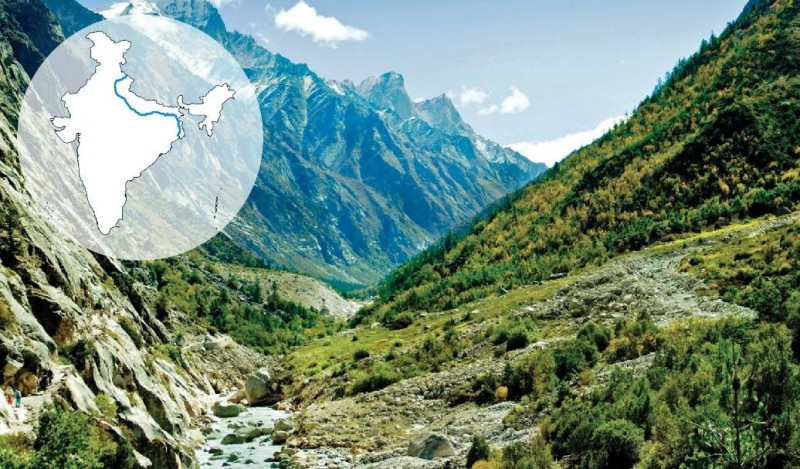
Then, downstream at Haridwar, the Ganga emerges into the plains where her course to the sea is marked by the confluence at Prayag in Allahabad in Uttar Pradesh. Here Ganga is joined by Yamuna and symbolically by the third goddess, Saraswati. Varanasi is likewise graced by the waters of Ganga Maharani. Of Ganga’s flowing locks that comprise the river’s delta, the Hooghly passing through Kolkata in West Bengal, has the privilege of hosting the final place of pilgrimage at the small island of Ganga Sagar where the goddess, after 2,525 km, merges with the Bay of Bengal.
Yamuna: Bountiful beauty
The source of the second goddess Yamuna, the younger sister of the Ganga, is marked by scalding hot springs at Yamnotri. She rises from the snows of the Bander Poonch massif near Uttarakhand’s border with the state of Himachal Pradesh. While passing near Mussoorie in Uttarakhand, the winding course of the river has an Ashokan edict on its banks extolling the virtues of non-violence. The goddess exits the Himalayas at Paonta Sahib, a Sikh pilgrimage hallowed by the residence of the Sikh Guru Gobind Singh. Its waters help give the state of Haryana in India its name signifying dazzling greenery.
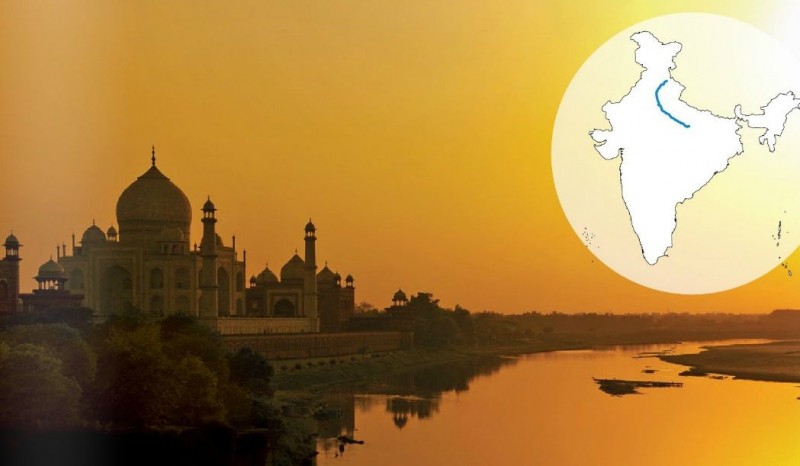
Once it nears New Delhi, the capital of India, the goddess is assailed by urban challenges. Downstream of the capital, the river flows past the ghats at Mathura in Uttar Pradesh where the votaries of Radha and Krishna gather. It curls round the dreamy profile of the Taj Mahal at Agra in Uttar Pradesh, then winds her way through eroded terrain where the Chambal joins her. Finally, before the auspicious meeting of the rivers at Prayag, 1,370 km from her source, the Yamuna is refreshed by the blue waters of the Betwa.
Godavari: Promise of prosperity
Godavari, Ganga’s elder sister, is a non-Himalayan river. Her flow is seasonal. She drains the lesser ranges of Deccan Plateau which receives little precipitation outside the monsoon. Her source is atop the black mesa formations of the north Sahyadri range. At the foot of these mountains is the sacred Trimbakeshwar Temple near the town of Nasik in the state of Maharashtra. The river flows for 1,465 km across almost the width of the peninsula from Nasik in the Western Ghats to cut through the Eastern Ghats leading to Yanam which was a former colonial outpost of Puducherry in Andhra Pradesh.
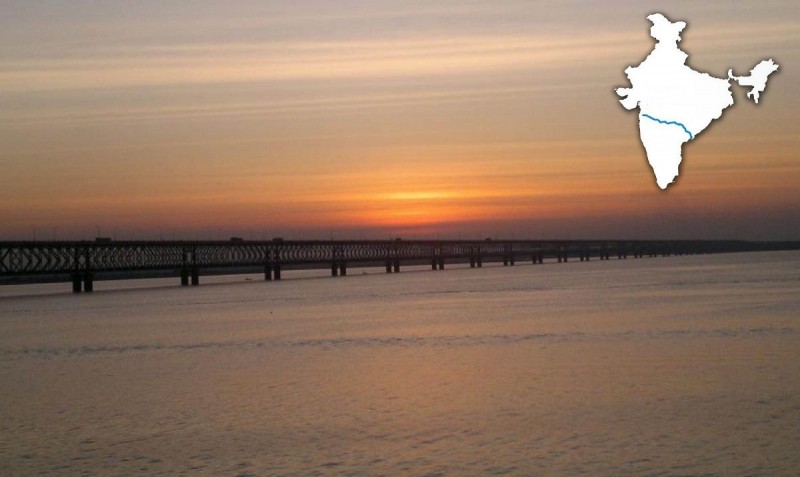
The small town of Paithan in Maharashtra lay on an ancient trade route and is famous for heavy silk saris. Shirdi is another small town near the Godavari that has become a place of pilgrimage. Downstream is the well-maintained gurudwara at Nander where Sikh Guru Gobind Singh breathed his last. The southeast flow of the river after it leaves Maharashtra for the state of Andhra Pradesh is supplemented by river Manjra from the south and Pranhita and Indrawati from the tribal districts lying to the north. The goddess takes a sharp turn at the Bhadrachalam Temple in Andhra Pradesh before cleaving a passage through the Eastern Ghats. She then descends in a broad southerly flow to the agricultural town of Rajahmundry in the state of Andhra Pradesh which marks the entrance to the fertile delta. Here the Draksharama Temple commanding the Gautam Godavari delivers final blessings before the goddess flows via Yanam into the Bay of Bengal.
Narmada: Auspicious beauty
Narmada, daughter of Lord Shiva, is to many the most beautiful. Her source is at Amarkantak amidst the leafy Maikala Hills of eastern Madhya Pradesh. It then passes through tribal territory thick with bamboo and rich in iron ore. At the medieval fort of Mandla in Madhya Pradesh, the river broadens out. The erstwhile ruling dynasty of the area boasts of being the last to hold out against the Mughal advances. Near Jabalpur in Madhya Pradesh are the Dhuandar waterfalls in the fabled marble gorge. The many hues of marble are said to be auspicious for carving temple images.

Large smooth basaltic lingams are also found in Narmada’s bed. Jabalpur lays claim to inventing snooker; it is said to have first been played here in colonial times. Omkareshwar is a scenic island with an ancient Jyotirlinga Temple and in contrast, this pilgrim site is followed downstream by the princely bathing ghats at Maheshwar. These were built by the widowed Holkar queen Ahalya Bai of the Maratha-ruled Malwa kingdom who bravely stood up for her family faith in the face of bigotry. Lower in its course, the river is dammed to form the Sardar Sarovar, a gravity dam near Navagam in Gujarat. Finally, at the estuary town of Bharuch in Gujarat, it flows into the Arabian Sea.
Saraswati: Alive in folklore
The holy river Saraswati is the Hindu goddess of learning. Beautiful to look upon, Saraswati holds the ancient stringed veena and is seated upon a swan. In ancient scriptures, Saraswati was a broad river that used to water what is now the Rajasthan desert. It was discovered under the sand in the 1930s from the remains of the Harappan civilisation. According to satellite imagery, the course of the dried-up river can still be discerned and in Hindu folklore, the Saraswati remains very much alive.
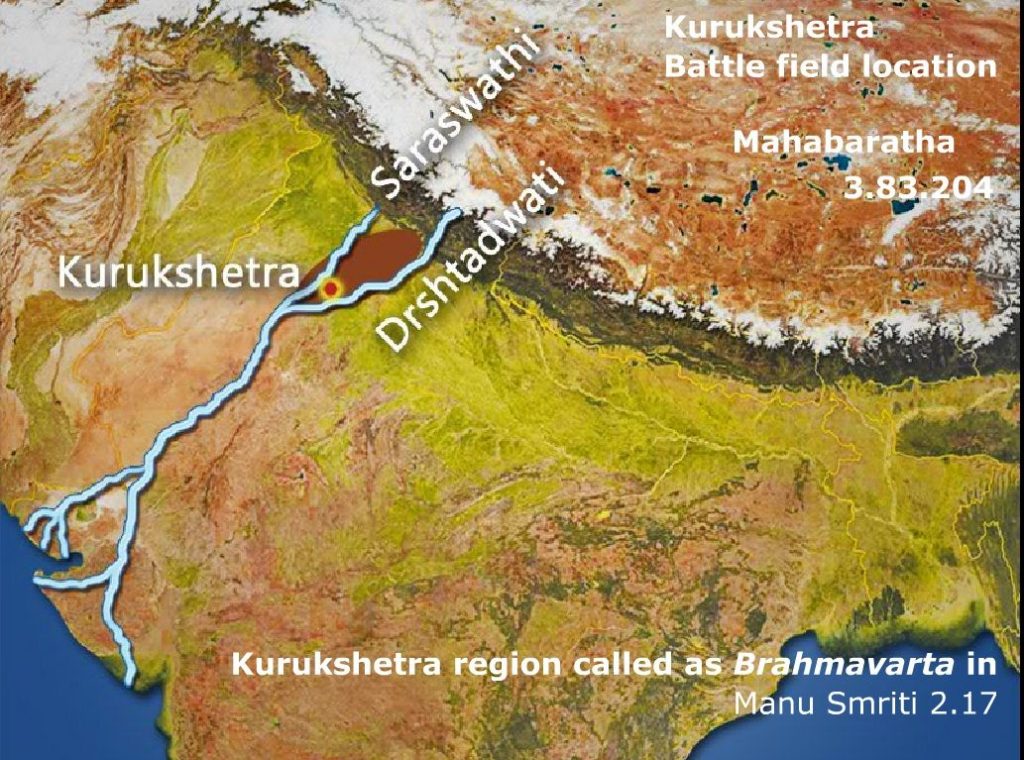
Recently, at Ad Badri in the Shivalik foothills of Haryana, the source of a small river, known as the Sarsutti, has been developed as a pilgrim centre. Both Kurukshetra in Haryana and Pushkar in Rajasthan have lakes associated with this lost sacred river and host huge gatherings of pilgrims on auspicious bathing days. It is assumed that the Saraswati flowed into the Rann of Kutch in Gujarat and then into the Arabian Sea.
Indus: High and mighty
The Indus gave its name to India – foreigners referred to it as the land that lies “beyond the Indus.” Also known as the Lion River, the Indus (or Sindhu) is the largest in the subcontinent, flowing for 3,200 km from undistinguished springs in Tibet, north of Mt Kailash. The flow of the river is determined by season – it diminishes in winter while flooding its banks between July and September.

This mighty river delimits the western end of the Great Himalayan range and the towering height of the Naga Parbat massif at the river’s sharp turn to outflank the mountain astounds all who behold it. From Tibet border, it flows northeast through Leh past the town’s huge and fascinating mud fort. At Nyemo, the Zanskar River joins the Indus at perhaps the most sublime confluence in the Himalayas. The river is worshipped by fishermen downstream in the Pakistan province of Sind where the shallow and sluggish Indus reaches the Arabian Sea.
Kaveri: Guardian of cultural wealth
Goddess Kaveri may be the shortest in length (765 km) but is the guardian of the most scintillating array of India’s cultural wealth. Known as the ‘Ganga of the South’, the goddess is depicted standing wearing a red silk sari and holding a copper water pot from which she pours her blessings. Kaveri (or Cauvery) rises in the hills of Coorg in the Karnataka section of the Western Ghats above the temple at Bhagamandalam. The source is known as Talakaveri and a small tank has been built to receive the overflow from the sacred spring. From the wooded hills of Coorg, the river flows to the confines of Mysore, then past Srirangapatnam in Karnataka where Tipu Sultan had his palace.

On the banks of Kaveri at Talakad near Mysore in Karnataka stands a strange spectacle of medieval temples silted up by the sand and wind. The goddess in her regal mood is seen at the spectacular Shivanasamundra Waterfalls and then again at the dramatic cataracts of Hogenakkal near the border of Tamil Nadu. As she approaches the delta region, the goddess unleashes a display of artistic, architectural and musical wonders. Trichy’s fort, the devotional rendering of Tyagaraj’s songs at Thiruvaiyaru in Thanjavur district in Tamil Nadu, Sriramgam’s extensive godly enclosure, the exquisitely poised bronze images of Cholan figures and Thanjavur’s towering temples and are a few of the living treasures of the delta region. The recognised channel of the Kaveri debouches into the Bay of Bengal near the coast at Poompahar in Tamil Nadu known to Roman traders as Kaveri Emporium.
Bharat
Telhara University – Older than Nalanda, Vikramshila Universities
Published
4 years agoon
December 29, 2020By
Vedic Tribe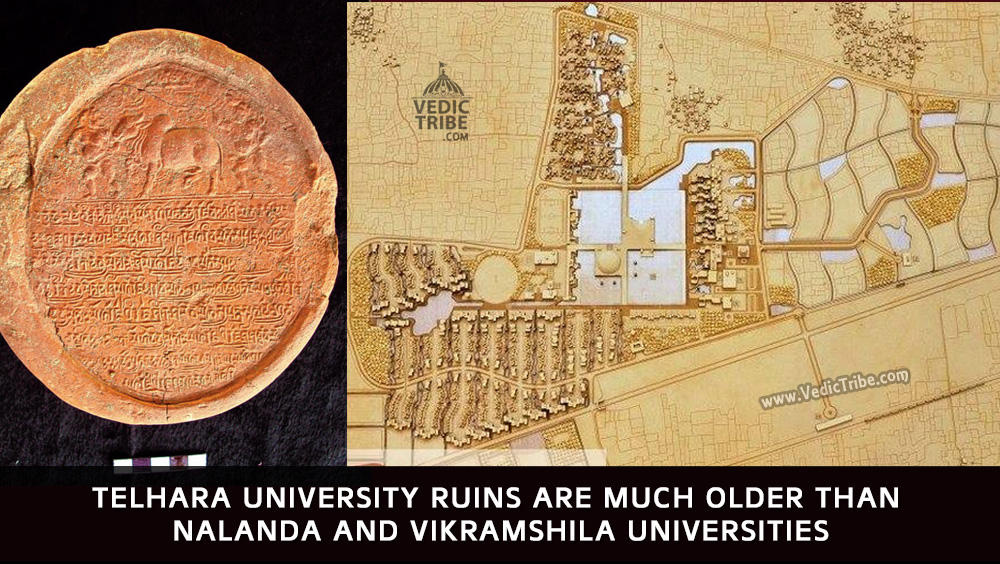
It was a useful mound, no doubt. A good vantage point where villagers occasionally relieved themselves.
But who would have thought that deep beneath its golden brown earth would be stories of dynasties and empires that now suggest that this — Telhara, a village 33 km from the ruins of the more famous Nalanda University — could be ‘Tilas-akiya’ or ‘Tiladhak’, the place Chinese traveler Hiuen Tsang visited and wrote about during his travels through India in 7th century AD? So far, there were only vague references but recent excavations at the mound suggest that Telhara was indeed an ancient university or seat of learning with seven monasteries.
The Bihar government has been calling the Telhara project one of its biggest after the excavations that unearthed Nalanda and Vikramshila universities. The excavation at Telhara should have happened earlier, say experts, but the site lost out to the more famous Nalanda.
The Telhara project that started on December 26, 2009, has so far come across over 1,000 priceless finds from 30-odd trenches — seals and sealing, red sandstone, black stone or blue basalt statues of Buddha and several Hindu deities, miniature bronze and terracotta stupas and statues and figurines that go back to the Gupta (320-550 AD) and Pala (750-1174 AD) empires. But the 2.6-acre mound has now thrown up the most tantalising find yet — evidence of a three-storied structure, prayer hall and a platform to seat over 1,000 monks or students of Mahayana Buddhism.
The terracotta monastery seals — a chakra flanked by two deers — unearthed at Telhara are similar to those at Nalanda, suggesting Telhara or Tiladhak was another great seat of learning besides Nalanda and Odantpuri during the Gupta and Pala reigns. It was the discovery of a similar monastery seal that clinched it for Nalanda University.
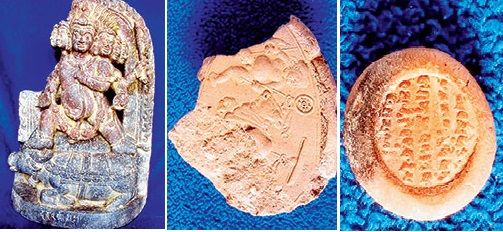
Former Archaeological Survey of India director B S Verma, who between 1971 and ’81 supervised the excavation at the site of the ancient Vikramshila university, says, “Telhara or Tiladhak has much more convincing epigraphical proofs — monastery inscriptions — than Vikramshila. The findings that match Hiuen Tsang’s account do more to convince that the place was a university or mahavihara similar to Nalanda.”
In his book, The Antiquarian Remains in Bihar, historian D R Patil writes about Hiuen Tsang’s description of Telhara. “Hiuen Tsang describes Telhara or Tilas-akiya as containing a number of monasteries or viharas, about seven in number, accommodating about 1,000 monks studying in Mahayan. These buildings, he says, had courtyards, three-storied pavilions, towers, gates and were crowned by cupolas with hanging bells. The doors and windows, pillars and beams have bas relieves (sculptures in guilded copper). In the middle vihara is a statue of Tara Bodhisatva and to the right (is) one of Avlokiteshwar”.
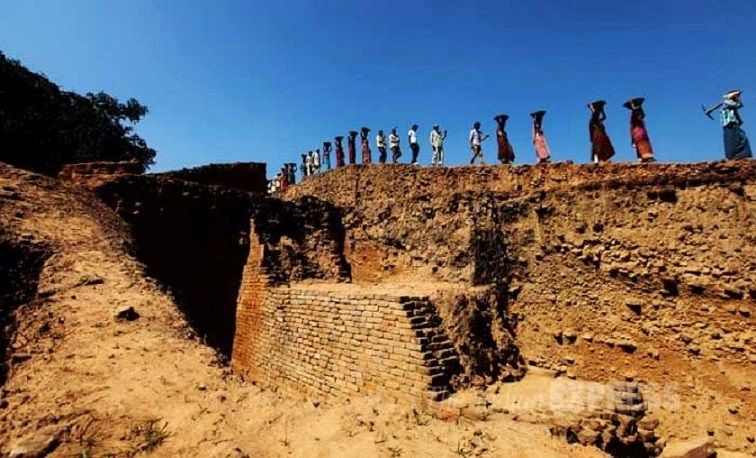
Other history books too talk of Tiladhak monastery, on the western side of Nalanda, as having four big halls and three staircases. It is said the mahavihara or university was built by one of the descendants of Magadha ruler Bimbisara. The monastery was decorated with copper and also had small copper bells that gently chimed in the breeze.
For months now, the excavation has been unearthing these stories. Apart from the mound that is now being dug up, Telhara has six other mounds — five of which have settlements and one which is partially elevated.
Atul Kumar Verma, director (archaeology) of the Bihar government’s Department of Art and Culture, says, “Since the excavations suggest that Telhara might have been a contemporary of Nalanda, it is quite possible that it was either an independent university for specialized education or that students graduating from Nalanda University would come here for specialized study. It is a great feeling to see the place emerging as the next big find after Nalanda. It has also aroused great curiosity and attracted even the likes of Nobel laureate Amartya Sen.” Sen wrote in the visitors’ book: “What a wonderful site, really thrilling! And so skillfully excavated and restored.”
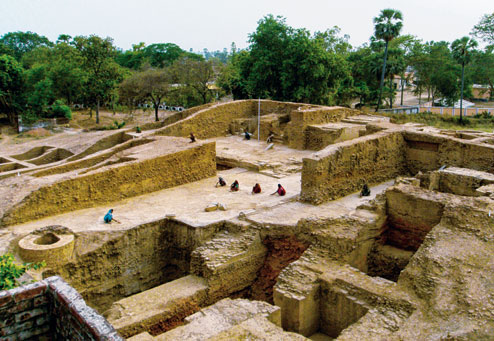
“We have found the courtyard that might have been an extension of the platform Hiuen Tsang had described,” Nand Gopal, camp in-charge at the Telhara site, says, peering into his optical line meter that’s mounted on a tripod.
In more recent times, it was A M Broadley, then magistrate of Nalanda, who in 1872 wrote about “Tilas-akiya” as a university and site of learning. British army officer and archaeologist Sir Alexander Cunningham, who visited the place between 1872 and 1878, wrote about inscriptions describing “Teliyadhak” as a place that had seven monasteries and which matched Hiuen Tsang’s account. A statue of the 12-armed Avlokiteshwar Buddha found from a Tiladhak site is at the Indian Museum in Kolkata. Perhaps the best known Pala sculpture from Telhara is now in Rietberg Muzeum, Zurich.
Though there was this and more proof that Telhara could be sitting on a glorious past, it wasn’t until December 2009 that the excavations finally began. Telhara panchayat head Awadhesh Gupta claims to have been the one who got things started.
“We all knew Telhara was once a great seat of learning, but nobody did anything to prove it. In 1995, I approached the Congress government requesting that the place be excavated but got no assurance. When Bihar Chief Minister Nitish Kumar visited the site in 2007, I put up this demand once again. The villagers were not happy with me. They thought I should have demanded something more concrete than just the digging of a mound.”
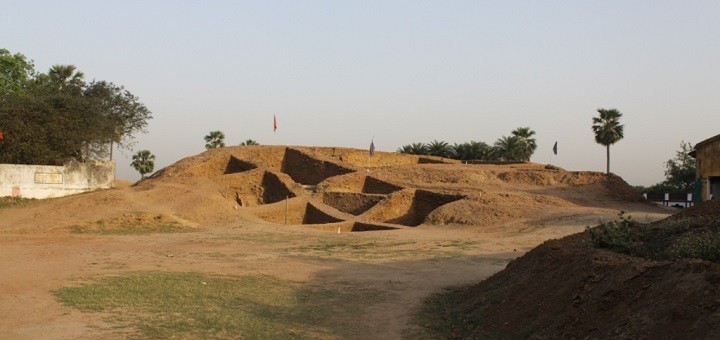
But the mukhiya may have had the last laugh. Villagers now talk about Telhara being part of the Nalanda-Rajgir circuit and how that could bring them jobs and better opportunities. “We hope the site is conserved and clubbed with Nalanda to attract tourists. The site has already given temporary jobs to 70 villagers,” says Anil Kumar, a villager.
It was a useful mound, no doubt.
Experts associated with its excavation are now claiming that the university originated in the Kushan period.
Atul Kumar Verma said that in the recent excavation, archaeologists have found some bricks of very large size (42x36x6.5cm) substantiating that the university belonged to the Kushan period. “Bricks of the Kushan period were quite large from other dynasties, including the Gupta and Pala periods,” said Verma.
While the Kushan period is considered to be 1st century AD, the Gupta dynasty ruled from 3rd to 6th century AD.
MAJOR FINDINGS
SEALS AND SEALING
The recovery of over 100 terracotta seals and sealings from the Gupta and Pala periods provides strong evidence of this being a Buddhist university. Besides seals of the chakra flanked by two deers, other seals have inscription of Buddhist mantras. Seals of Gaj-Lakshmi and flying birds were also found. Some inscriptions that have not yet been deciphered would be sent to Mysore for deciphering.
PLATFORM, TEMPLES
Just above the ashen layer — said to be proof of Turkish general Bakhtiyar Khilji having destroyed the monastery — is the sanctum sanctorum of three Buddhist shrines, each measuring 3.15 square metres. A big platform, found just below this ashen layer, is said to have accommodated over 1,000 monks.
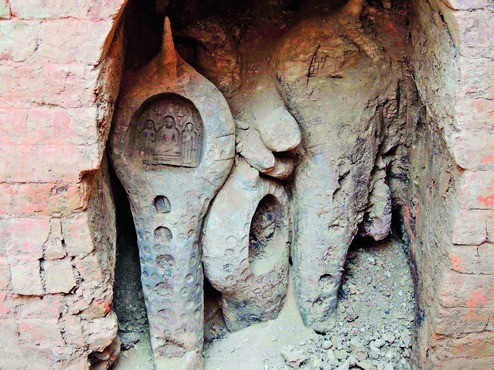
CELLS FOR TEACHERS
The excavation has so far revealed 11 cells of 4 square meters each. It is believed that these were faculty quarters. There is evidence of bricks from the Gupta and Pala periods.
COPPER BELL CHIMES
The excavation revealed several broken pieces of small bells. Parts of molten copper also suggest that the monastery was well-decorated.
CAUTION INSCRIPTION
A stone inscription in Sanskrit (early Nagari script), probably written just before the destruction of the Tiladhak mahavihara, says, “He who tries to destroy this monastery is either a donkey or a bull”. Below the stone inscription are images of the two animals.
FASTING BUDDHA AND VOTIVE STUPA
A miniature terracotta image of a fasting Buddha from the Pala period is a rare find. A six-foot-tall votive stupa from the Pala period suggests the prevalence of Buddhism.
MAURYAN PERIOD
Bone tools and pottery shards of Northern Black Polished Ware points to this being a settlement in the Mauryan period.
STONE SCULPTURES
Among the over 15 stone sculptures found at the site are a red sandstone sculpture of Bodhisatva, Avlokiteshwar, Manjusri and the Buddha in his ‘earth witness’ mudra. A black stone statue of Buddha in abhay mudra (fearless mode) from the Pala period has been found. The red sandstone Bodhisatva sculpture is believed to be from the Gupta period. Some sculptures of Hindu deities such as Uma Maheshwar and Ganesh and Vishnu from the later Pala period were also found. The presence of a Yamantaka sculpture is evidence of Tantric Buddhism at the monastery.
Bharat
Macaulay’s Children are still thriving in India
Published
4 years agoon
December 29, 2020By
Vedic Tribe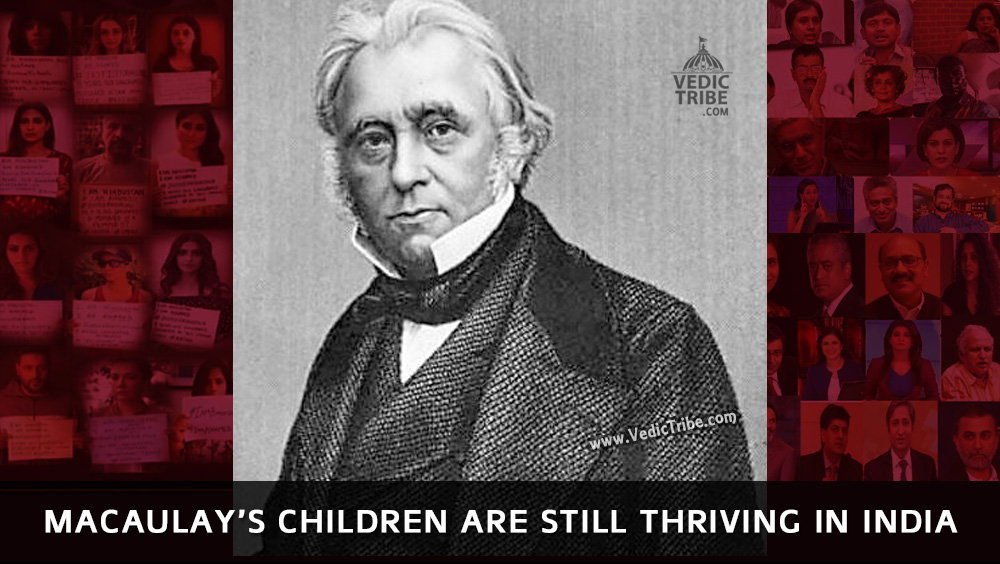
~ Subhash Kak, Indian American Computer Scientist, Regents Professor and Author
Imprinting is the key that explains many of our peculiarities. Imprinted birds and mammals act as if they were human. Goslings, when reared by a person, become imprinted to the caregiver, and they will ignore geese. Imprinted people live in their own world of symbols, and their behavior to an outsider would appear strange.
Imprinting occurs during a sensitive window of development. Imprinted animals will mate with their own kind but will prefer the animal to which they have been imprinted. In extreme cases they will refuse social contact with their own kind. Imprinting is fixed for life; it occurs also in motor patterns, as in birdsong. Humans are also imprinted— to ideas and beliefs they are exposed to in their childhood.
All this has been known for a long time. Herodotus tells us of how hostage children raised in court became loyal to their captors. In the US, Canada, Australia, the children of the natives were forcibly taken from their parents and put in foster homes for this reason.
The Ottoman Empire built a bizarre but effective system based on this idea. It created the institution of the Kapi Kullari (“Slave” or “Ruling Institution”), whose members were legally slaves of the sultan: they were born Christians but were converted to Islam primarily through the practice of devsirme, where able-bodied young children were recruited as child-tribute and immersed in Islamic culture.
The kullars were forbidden to contract legal marriage, to have acknowledged children, and to own private property. They served solely at the pleasure of the sultan, at whose will they were promoted and executed. The slave status divested the kullars of any personality outside the service of the master.
The kullars as Janissaries were the best regiments of the Ottoman army; they also served in the palace jobs and as provincial governors. The Grand Vizier was invariably a kullar. They constituted a superlative bureaucracy: they were devoted to their duties, were completely loyal and since they were isolated from the general population, they were fair. Their non-hereditary status prevented the formation of a ruling elite that might threaten the sultan.
With time, the kullars began seeking reforms in their inhumane system. By the end of the Empire, they had won the right to matrimony. But as their circumstances changed they became venal; what was their strength as an isolated community now became a license to do good only for themselves.
If the kullars constituted the backbone of the Ottoman Empire, an institution, similar in spirit but somewhat different in form (but more subtle and resilient), was formed to safeguard the British Empire in India. This was the institution of the brown sahib, the colonial apologist, formed under the directive of the famous Minute of Macaulay (1835) who wished to create “a class who may be interpreters between us and the millions whom we govern; a class of persons, Indian in blood and colour, but English in taste, in opinions, in morals, and in intellect.” These Indian kullars may be properly called Macaulay’s children.
The central idea in the imprinting of the Indian kullars was Macaulay’s assertion that “a single shelf of a good European library was worth the whole native literature of India.” The British, following Macaulay’s ideas, dismantled the traditional pathshala system of village education, which had provided universal literary to the people. William Adam, a Scottish missionary in Bengal and Bihar during 1835-7, estimated that there were 100,000 pathshalas which were popular with all classes of people, “irrespective of their religion, caste, or social status,” and the “curriculum was designed towards meeting the practical demands of rural society.”
The village school had great room for improvement but it was very effective and was one of the institutions of local power. When it was superseded by the new system, controlled by the British bureaucracy using an alien language whose benefit ordinary people could not see, children of the poorer classes simply pulled out. This led to the illiteratization of the great masses of the Indian population.
The Macaulayite bureaucracy worked against other traditional knowledge also. For example, it targeted the millennia-old system of water tanks, which had been serviced by village councils. In its place was instituted a system of canal irrigation. This was done even where it was unsuitable, and the local councils were disbanded. Soon, the tanks fell into disuse and the water table dropped; this had disastrous effects for agriculture.
In the colonial state, the idea of profit was replaced by that of service of the British empire. The new system of education was instrumental for the socialization of this view. The idea of the other-worldly Indian was promoted.
In 1947, there was hope that India would create a progressive nation-state, but Macaulay’s children quietly seized power. Taught to hate India’s past and lacking a defining center, they took the fashions of the day–such as Socialism and Marxism–, and elevated these to their religious ideology. The terms Socialism and Secularism–but with a perverted meaning–were even written into the Indian Constitution during the Emergency of the mid-1970s.
In awe of the British and insecure of their positions, those of the Macaulay children who went into governance were good administrators. But as the system of checks and balances eroded after independence, they lost their reputation for incorruptibility.
Blind adherence to an ideology can stunt intellectual and emotional growth. Such people are forever seeking approval from those whom they idolize, and they are unable to grasp the incongruity of their behavior. Emotionally stunted people are like imprinted children, who can be very cruel. (The Khmer Rouge massacres of Cambodia, amongst the most horrific of the past century, were carried out principally by teenagers imprinted to one brand of Marxism.) Adults, with the minds of children, also brook no opposition, although their ways may not be as drastic.
The Macaulayite establishment in India is especially intolerant: it also knows a few tricks of Stalin. It silences its opponents using censorship and a system of patronage. But recently, independent minded American-style Internet magazines have provided a means to side-step this censorship.
Take Arun Shourie’s experience: Although India’s most famous and recognized journalist and author, winner of the Magasaysay award, he was black-listed by mainstream publishers and the media as soon he turned his attention to subjects considered taboo by the establishment. During the last ten years he has been compelled to self-publish his books and newspapers have banned him. But thanks to his Internet column he remained hugely popular until he joined the Vajpayee administration as a minister and stopped writing.
Having been black-listed once, his books are still not reviewed, and his speeches as a minister are rarely reported unless his words can be twisted to paint him as a monster. He is like a non-person of the apartheid South Africa. The favorite abusive label to pin on the opponent is to call him “communalist” or “fascist”, and Shourie has carried these labels frequently.
As another example consider Mark Tully, the distinguished British journalist and author, who was for a long time the bureau chief of BBC in Delhi. Just because one of his books was perceived as somewhat critical of the Macaulayites, he was called names and declared a sell-out. His books have also stopped receiving notices.
This is quite unlike the rivalry between the liberals and the conservatives in the West, where the most partisan writers concede that their opponents have the right to be heard through the print and the TV media.
Some have suggested that the current turmoil in India is just a struggle between the traditional and modern approaches to governance. Nothing could be further from the truth. The opponents of the Macaulayites and Marxists do not wish for a religious state. They want to build a modern society somewhat like that of the United States: forward-looking but yet connected to its culture.
Reading the reportage of the culture wars of India by Western journalists in a hurry, one gets the feeling that the only sane people in India are these Macaulay’s children. The reformers are labeled nationalists, swamis, traditionalists, or worse. These journalists do not understand the real nature of the struggle.
It is funny. The West proclaimed a certain imagined view on India, and now its pupils insist this is the real thing, even though there is evidence to the contrary for everyone to see.
Could there be a better case of the tail wagging the dog?
Follow us on Facebook
Follow us on Twitter
Latest


Seven Vows and Steps (pheras) of Hindu Wedding explained
Views: 6,403 Indian marriages are well renowned around the world for all the rituals and events forming part of the...


Sari or Saree is symbol of Indian feminism and culture
Views: 5,542 One of the most sensual attires of a woman in India is undoubtedly the sari. It is a...


Atithi Devo Bhava meaning in Hinduism and India
Views: 4,789 Atithi Devo Bhava, an ancient line taken from the Hindu scriptures and was originally coined to depict a visiting person whose...


Sanskrit Is More Than Just A Method To Communicate
Views: 4,004 -By Ojaswita Krishnaa Chaturvedi anskrit is the language of ancient India, the earliest compilation of sound, syllables and...


Significance of Baisakhi / Vaisakhi
Views: 4,924 Baiskhi is also spelled ‘Vaisakhi’, and is a vibrant Festival considered to be an extremely important festival in...


Navaratri: The Nine Divine Nights of Maa Durga!
Views: 5,974 – Shri Gyan Rajhans Navratri or the nine holy days are auspicious days of the lunar calendar according...


History of Vastu Shastra
Views: 8,411 Vastu Shastra (or short just Vastu) is the Indian science of space and architecture and how we may...


Significance of Bilva Leaf – Why is it dear to Lord shiva?
Views: 7,665 – Arun Gopinath Hindus believe that the knowledge of medicinal plants is older than history itself, that it...


Concept of Time and Creation (‘Brahma Srishti’) in Padma Purana
Views: 8,514 Pulastya Maha Muni affirmed to Bhishma that Brahma was Narayana Himself and that in reality he was Eternal....


Karma Yoga – Yog Through Selfless Actions
Views: 7,936 Karma Yoga is Meditation in Action: “Karma” means action and “yoga” means loving unity of our mind with...

